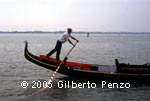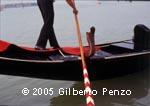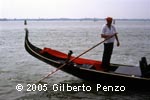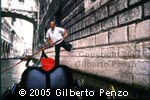|
|
|

Stalia vista di fianco |
PrŔmer
e Stalia
La vogata si pu˛
suddividere in due fasi, corrispondenti al movimento di
andata e di ritorno al punto di attacco del remo: quello
effettivo di spinta, che si chiama prŔmer ,
durante il quale il vogatore immerge verticalmente la pala
e spinge sul girˇn , e quello di ritorno o stalýr
nel quale lo si riporta nella posizione di partenza. Il
primo movimento Ŕ tutto sommato abbastanza intuitivo, un
poĺ pi¨ complesso da capire Ŕ il movimento successivo
nel quale si fa ritornare velocemente il remo al punto di
partenza, mantenendolo immerso con il bordo anteriore
della pala inclinato verso il basso, in modo sfruttare la
sua resistenza per correggere la rotta.
Per evitare che la resistenza dellĺacqua faccia uscire
il remo dalla sua sede - come succede spesso ai
principianti - basta premere sullĺimpugnatura per
schiacciarlo sulla fˇrcola e trattenerlo al suo posto. In
questo modo il morso pu˛ essere aperto basta
solo che abbia il nasŔlo (cioŔ la punta
inferiore leggermente incurvato verso lĺalto per offrire
un sufficiente attrito per bloccare il remo.
PrŔmer
and Stalia
The stroke
can be divided into two phases: the prŔmer (push)
in which the oarsman immerses the blade vertically and
pushes on the shaft of the oar, and the stalýr
(return stroke) in which the oar is moved to its starting
point. While the push stroke is fairly intuitive, the
return stroke is a complex movement in which the oar is
kept underwater and is brought to its starting point
keeping the forward edge of the blade inclined downawards.
This 'rudder effect' is used to correct the direction of
the boat.
To prevent
water resistance from pushing the oar from its resting
point - as is often the case with beginners - the
grip of the oar is pressed so as to push the oar onto the fˇrcola
and keep it in place . In this way the m˛rso (the
pivot point for the oar) can be left open leaving just the
nasŔlo (the lower point) curved slightly upwards
to block the oar.
|
|
|

Stalia vista di prua |
Stalia
Sĺintende
che se la stalýa fosse equivalente alla spinta
la barca rimarrebbe diritta sý ma ferma, pertanto si sono
cercati tutti gli accorgimenti possibili per ridurre al
minimo lĺeffetto di frenata alla ricerca del massimo
rendimento. Non per nulla le regate ad un solo remo sono
considerate lĺuniversitÓ della voga, richiedendo sý
forza ma anche tecnica, stile ed esperienza.
Oltre
alla tecnica di voga contribuisce molto lĺassetto della
barca, tenuta inclinata e deviata verso destra in modo
che, come si dice, vada a cascÓr stagÓndo.
Questo assetto si ottiene spostando il carico o i vogatori
sulla destra o addirittura creando barche appositamente
"storte" come la gondola
o il puparýn che galleggiano, per la loro
conformazione asimmetrica, sbandate a destra.
Of course
if the return stroke were the same as the push stroke, the
boat would point in the right direction but would be
more-or-less motionless. Therefore every possible
technique is employed to reduce the 'braking' effect of
the return stroke so as to gain the maximum forward
motion. It is not surprising that single-oar regattas are
considered the 'university' of Venetian rowing: they
require strength and stamina, but also technique, style
and experience.
The
direction of the boat can also be corrected by having the
boat lean to the right. This can be achieved by shifting
the passengers, the load or the oarsmen to the right side
of the boat or by creating boats that are 'bent', such as
the gondola or the puparýn.
|
|
|

Voga
sotom˛rso. |
Partenza
La
partenza avviene facendo leva sulla base della fˇrcola,
cioŔ vogando sotom˛rso, imprimendo una serie
rapida di movimenti di andata e ritorno al remo - che
rimane sempre immerso - in modo da avviare la barca
tenendola sotto controllo con il minimo scarroccio
possibile.
Poi,
quando la barca ha raggiunto un sufficiente abbrivo, si
passa il remo sul m˛rso per la vogata normale
illustrata precedentemente. La virata a sinistra, per
andÓr a premÓndo, Ŕ semplice e intuitiva: basta
spingere sul remo; viceversa quella a destra, lĺandÓr
stagÓndo, richiede che il remo, nel movimento di
ritorno, faccia maggiore leva sotto lĺacqua come nella stalýa,
accostando la prua verso destra.
Starting
To give the
initial 'push' to get the boat moving, the gondolier uses
the base of the fˇrcola as a pivot for the
oar using a series of rapid side-to-side movements of the
oar - which is kept immersed - so as to keep the boat
under control with the minimum aount of leeway. Once
the boat is underway, the oar is placed on the m˛rso
for the normal rowing style described above.
Turning
A left turn
- andÓr premÓndo - is simple and intuitive: it requires
a good push on the oar; for a right turn - andÓr
stagÓndo - the oar is moved in the same way as in the
reutrn stroke (stalýa), but with greater
leverage so as to point the bow to the right.
|
|
|

Siada bassa |
Arresto
Lĺarresto o siÓda,
si effettua anteponendo il remo alla fˇrcola nella sÓnca
, tenendolo immerso di taglio nellĺacqua, con
maggior o minor decisione a seconda della urgenza della
frenata; in caso di necessitÓ, per evitare uno scontro
imminente, si tira ripetutamente con vigore sul remo in
modo da fare pi¨ resistenza nellĺacqua.
Ci
sono due tipi di arresto: quello che porta la barca a
deviare verso destra dove il remo Ŕ messo sulla parte
bassa della fˇrcola eseguendo la manovra detta siÓda
bassa, e quello che la mantiene diritta o la porta
verso sinistra con il remo messo nella parte alta della fˇrcola
sotto la sporgenza della testa o rÚcia, detta siÓda
alta.
Stopping
To
stop the boat - siÓda - the oar is brought onto the sanca
with the blade of the oar more or less vertical depending
on the urgency of the manouevre; if necessary, to avoid a
collision, the oar is pulled frequently and forcefully to
create greater water resistance.
There are
two types of stopping manouevre: the siÓda a bassa
that causes the boat to turn to the right in which the oar
is placed on the lower part of the fˇrcola; and
the siÓda alta that keeps the boat straight or
turns it to the left in which the oar is placed in the
upper part of the fˇrcola under the recia (the
ear-like protrusion at the top of the fˇrcola).
|
|
|

Voga
indietro o indrio |
Voga
indrio
Per
retrocedere il gondoliere mette il remo avanti alla fˇrcola
nella sÓnca e si sposta verso poppa vogando con
movimenti circolari che spingono la barca allĺindietro e
ne correggono contemporaneamente la direzione.
Rowing
backwards
To move
backwards, the gondolier places the oar in the sÓnca in
front of the fˇrcola, and steps back rowing with
figure-of-eight movements that push the boat backwards
while correcting any changes to the direction.
|
|
|

Voga in canali stretti |
Voga
in canali stretti
Invece
per vogare nei canali stretti il gondoliere si sposta in
avanti sopra i trastolýni, a ridosso del sedile
dei passeggeri, e voga in sÓnca, con il remo
immerso che compie movimenti alternati in diagonale da
destra a sinistra come nella voga a bratto.
Rowing
in narrow canals
In narrow
canals, the gondolier moves forwards over the rear thwart
or trastolýni (the transverse boards that conect
the left and right sides of the boat) behind the passenger
seats, and rows in sanca with the oar immersed,
alternating left and right diagonal movements as in the voga
a bratto (see photo).
|
|
|

Virata
a destra col piede
|
Virata
a destra col piede
Per
finire cĺŔ una manovra un poĺ curiosa nella quale
invece delle mani si usa il piede; la si esegue quando,
nel compiere la virata a destra in un canale molto
stretto, lo scafo scarroccia e rischia di urtare con la
poppa sul muro delle case, allora il gondoliere allunga la
gamba sinistra fuori bordo dando una spinta che evita il
contatto. Using
the left foot to veer right
Finally,
there is a curious manouevre in which the gondolier uses
his feet . It is carried out when the gondola is veered to
the right in a very narrow canal where the gondola could
hit the wall. In this case the gondolier stretches his
left leg over the side of the boat and pushes against the
wall to avoid contact. |
|
|
|